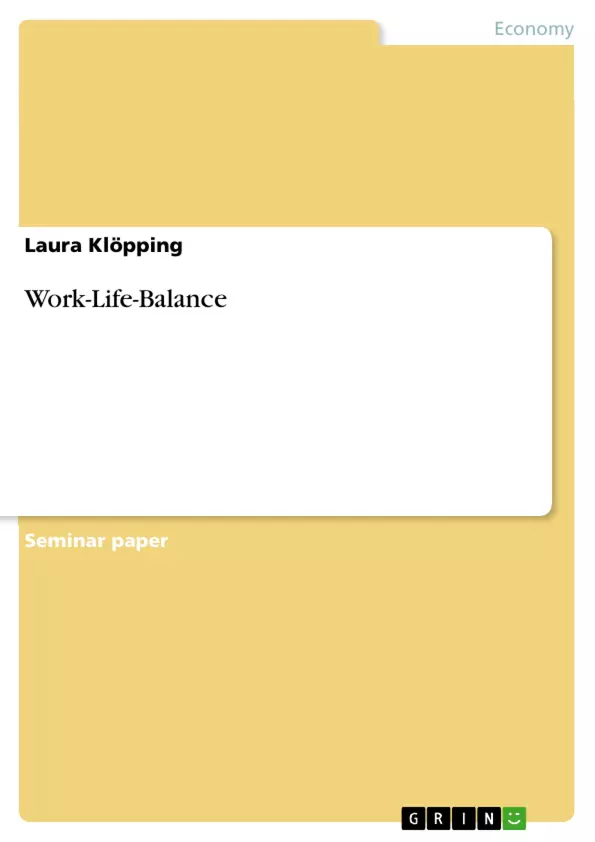Due to historical, economical and social changes the roles of work and workplace have changed. This assignment deals with the Work-Life-Balance of working women and men. The importance of this topic raised in the last few years and the need for flexible working models and for example the support of child care is getting more and more important. But how can Work-Life-Balance be defined and what is the importance of it?
There is no agreed definition of Work-life Balance. “Work-life Balance is about people having a measure of control over when, where and how they work. It is achieved when an individual's right to a fulfilled life inside and outside paid work is accepted and respected as the norm, to the mutual benefit of the individual, business and society”. Only if the relation between life and work, the triangle of time, money and health is balanced, humans can meet the demands of the age of communication with energy and love of life. Also it does not mean an equal balance in units of time. Related terms include "lifestyle balance" and "life balance". There is no perfect, one-size fits all balance one should be striving for. The best Work-Life-Balance is different for everyone because of different priorities and different lives. For some people it means to balance their caring responsibilities for children with work, while others want more time for themselves and for their leisure activities. Trying to schedule an equal number of hours for each work and personal activities is usually unrewarding and unrealistic because “life is and should be more fluid than that”
Summarized can be said that Work-Life-Balance can be defined as a satisfactory level of involvement or „fit‟ between the multiple roles in a person‟s life.
Table of Contents
- Introduction
- Historical Changes
- Economical and Social Change
- Social Change Considering the Role of Women
- Reasons for an Unbalanced Life
- External Reasons
- Demanding Job
- Pressure from Family, Society and Media
- Time Management and Establishing Priorities
- Internal Reasons
- Success Means Career
- Inner Safety Means Financial Safety
- Mistaken Beliefs
- External Reasons
- Affects of Imbalance
- Possible Arrangements to Implement Work-Life-Balance
- Balance in Work and Carrier
- Flex time
- Part-time
- Job sharing
- Working at home
- Sabbatical
- Balance in Private Life
- Child Care
- Health Care
- Balance in Work and Carrier
- How it Actually Works in Companies
Objectives and Key Themes
This assignment explores the concept of Work-Life-Balance for working women and men, focusing on the need for flexible working models and support systems, particularly in the context of childcare. It aims to define Work-Life-Balance and investigate its importance, highlighting the complexities of achieving a satisfying balance between work and personal life.
- Historical and societal changes impacting Work-Life-Balance
- The evolving role of women in the workforce and its impact on family life
- External and internal factors contributing to an unbalanced life
- The importance of implementing flexible work arrangements and support systems
- The current state of Work-Life-Balance practices in companies.
Chapter Summaries
The introduction defines Work-Life-Balance, acknowledging that it is a complex and individualized concept with no single definition. It emphasizes the importance of a balanced relationship between work and personal life, highlighting the need for flexibility and individual priorities.
Chapter 2 explores the historical changes that have contributed to the current emphasis on Work-Life-Balance, focusing on economic, social, and particularly the changing role of women in the workforce. The chapter examines the increasing pressure on both managers and staff due to globalization and rapid development.
Chapter 3 delves into the reasons behind an unbalanced life, distinguishing between external and internal factors. External reasons include demanding jobs, pressure from family, society and media, and challenges with time management and prioritizing. Internal reasons discussed include the belief that success equates to career advancement, the association of financial security with inner safety, and the influence of mistaken beliefs.
Keywords
The main keywords and focus topics include: Work-Life-Balance, flexible work arrangements, childcare, gender equality, economic and social change, globalization, pressure to perform, work-life integration, employee support systems, and individual priorities.
- Quote paper
- Laura Klöpping (Author), 2011, Work-Life-Balance, Munich, GRIN Verlag, https://www.grin.com/document/189359



